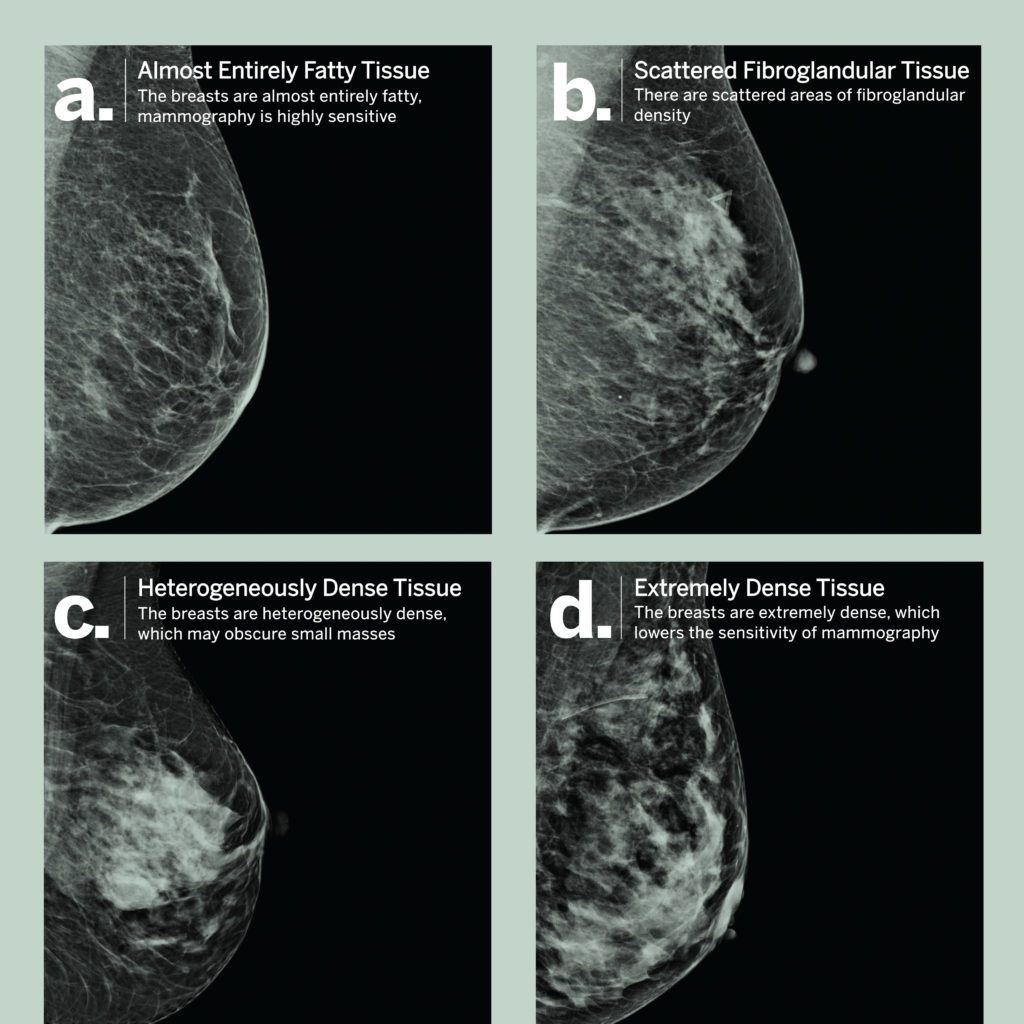Breast Density, what do I need to know?
Discover what it is and how it relates to mammograms.

Breast Density, what do I need to know?
|
As of April 1st, 2013, the California Breast Density Notification Law requires facilities that provide mammography services to communicate breast density information to patients who have dense breast tissue. |
We want you to be informed about breast density.
Let us help you understand your patient rights and test results. Most patients know very little about breast density, so we’ve put together a list of some frequently asked questions and added answers from our expert radiologists. We hope this information helps reduce any concerns you might you have. Of course, if you have additional questions don’t hesitate to make an appointment to talk to one of our healthcare providers.
BREAST DENSITY Q&A
Breasts are made up of a mixture of fibroglandular tissue and fatty tissue. “Breast density” is a term used to describe the amount of fat relative to fibroglandular tissue that the radiologist sees on a mammogram. Breasts are considered to be dense if there is a greater percentage of fibroglandular tissue as compared to fatty tissue.
On April 1st, 2013, the California Breast Density Notification Law (SB1538) took effect requiring any facility performing screening mammography to communicate breast density information to patients who have dense breast tissue. Dense breast tissue is a normal physical attribute. In fact, half of all women have dense breast tissue. The purpose of the law is to give you additional information about your body so you can make informed choices.
Although no other screening can replace mammography, your healthcare provider might order additional tests based upon your personal assessed risk for breast cancer. Keep reading more information on this.
The American Cancer Society and the American College of Radiology (ACR) recommend annual screening mammograms for women beginning at the age of 40 regardless of breast density.
Radiologists characterize each patient’s mammogram into one of the four categories listed below, from least dense to most dense. If you fall into the heterogeneously dense tissue or extremely dense tissue categories, you are considered to have dense breasts. FYI: Approximately half of the female population has dense breasts.
a. Almost Entirely Fatty …………………………….. Less Than 25% Glandular Tissue *
b. Scattered Fibroglandular Tissue …………… Between 25-50% Glandular Tissue *
c. Heterogeneously Dense Tissue ………………. Between 51-75% Glandular Tissue *
d. Extremely Dense Tissue ………………………… Greater Than 75% Glandular Tissue *
* Percentages listed above are intended to help patients understand the different categories of breast density and do not represent exact percentages.

Studies show that 3D tomosynthesis, also called 3D mammography, is superior to just 2D mammography for all categories of breast density. That’s why Women’s Imaging Center became the first fully accredited imaging center in Orange County to provide this additional screening as part of our routine screening exam.
For our patient population, 2D mammography combined with 3D tomosynthesis has shown a:
- 27% Increase in Overall Cancer Detection
- 40% Increase in Invasive Cancer Detection
- 15% Decrease in False Positive Findings
Having dense breasts does not necessarily put you at a higher risk for breast cancer but additional screening might be considered based on your overall risk. So it’s important to tell your healthcare provider if you have any of the risk factors listed below.
Be mindful that having one of these risk factors does not automatically place you in a high-risk category for breast cancer. Your healthcare provider will consider the combination of risk factors to assess your overall risk.
Here are some of the factors your healthcare provider might consider when calculating your individual risk:
- You have 1st degree relatives (mothers, sisters, daughters) that have/had breast cancer, especially at a young age (diagnosed under the age of 50)
- You have two or more cases of breast cancer that have occurred on the same side of your family
- You have not had any children or you had your first child after the age of 30
- You have had a history of previous benign breast biopsies certain types of non-cancerous abnormalities found in the breast tissue can increase the risk for breast cancer
- You have both breast and pancreatic cancer that has occurred on the same side of your family
- You are of Ashkenazi Jewish heritage with a personal or family history of breast or ovarian cancer
- You have a family history of male breast cancer
- After considering these factors, you and your doctor can decide what screening options are right for you. If your doctor believes that your individual risk is high, they may choose to order additional screening tests in addition to mammography such as a breast MRI or a screening ultrasound.
If you have no additional breast cancer risk factors, rest assured that your risk remains low. You can be an advocate for your health and well-being by practicing monthly breast self-exams, having an annual physical breast exam performed by a clinician, and continuing to get your annual screening 3D mammography exam. Following these practices can help in early breast cancer detection.
